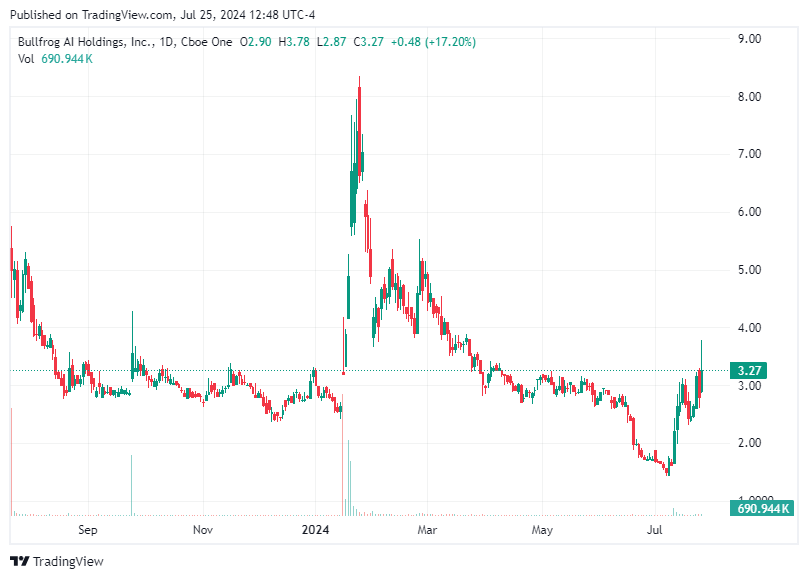Artificial Intelligence Company Reveals Major Insights For Bipolar Disorder Disorder Pathways
BullFrog AI and Lieber Institute for Brain Development Reveal New Insights into Bipolar Disorder Pathways and Potential Drug Targets.

Disclaimer: The following article is for informational purposes only and does not constitute medical advice. Always consult with a healthcare professional for medical advice, diagnosis, or treatment.
Real-time information is available daily at https://stockregion.net
BullFrog AI Holdings, Inc. (NASDAQ: BFRG; BFRGW), a leader in AI-driven drug discovery, has announced advancements in its ongoing collaboration with the Lieber Institute for Brain Development (LIBD). This collaboration has yielded pivotal insights into the molecular pathways associated with bipolar disorder (BD) and identified new candidate drug targets. These findings build upon the progress detailed in their May 16, 2024 release, further narrowing down the gene networks most involved in BD, thus paving the way for more targeted and effective research and treatment options.
Understanding Bipolar Disorder
Bipolar disorder is a complex mental health condition characterized by extreme mood swings, including emotional highs (mania or hypomania) and lows (depression). The exact causes of bipolar disorder are still not fully understood, but it is believed to involve a combination of genetic, environmental, and neurochemical factors. The identification of specific molecular pathways and gene clusters associated with BD can enhance our understanding of the disorder and lead to the development of more precise treatments.
BullFrog AI and LIBD have utilized advanced AI-driven analysis to pinpoint specific molecular pathways associated with bipolar disorder. Their latest research has focused on functional enrichment across various brain regions associated with BD. This analysis led to the identification of enrichment in six out of 68 clusters from the LIBD brain dataset. This means that six specific groups of genes or proteins, which are highly relevant to at least some cases of BD, were found among the many brain data clusters analyzed.
One of the notable findings from this research is the identification of two substantially enriched clusters in the Dentate Gyrus, a region critical for memory and cognitive function. This suggests a strong involvement of this area in BD pathology. The Dorsolateral Prefrontal Cortex (DLPFC), which is crucial for executive functions like decision-making and problem-solving, revealed one specific cluster associated with BD. This precise identification within the DLPFC highlights a key area for understanding and potentially treating BD.
The findings also highlight the potential dysregulation of pro-inflammatory pathways in individuals with BD. Inflammation has been increasingly recognized as a factor in various mental health disorders, including BD. By identifying novel pathways to the pathophysiology of BD, this research deepens our understanding of the disorder and identifies several putative drivers of the condition. These discoveries pave the way for developing targeted therapeutics aimed at these specific molecular mechanisms, offering hope for more effective and personalized treatments for patients suffering from BD.
The Role of AI in Neuropsychiatric Disorder Research
The collaboration between BullFrog AI and LIBD reveals the immense potential of AI in unlocking the complexities of neuropsychiatric disorders. Vin Singh, CEO of BullFrog AI, emphasized the importance of their proprietary bfLEAP™ platform and causal AI strategy in driving forward their mission to develop precise and effective treatments. The combination of BullFrog AI's technology and LIBD’s extensive brain data is proving to be a powerful tool in advancing our understanding of BD and other neuropsychiatric disorders.
While these findings are promising, further validation is necessary to confirm the identified molecular pathways and gene clusters. BullFrog AI and LIBD are now focusing on validating these findings in wet lab settings. This involves conducting experiments in laboratory settings to verify the results obtained through AI-driven analysis. Additionally, they are engaging with pharmaceutical partners to advance these discoveries and explore potential therapeutic applications.
Dr. Daniel R. Weinberger, Director and CEO of LIBD, expressed his enthusiasm about the potential impact of these findings on developing new targeted therapies that could improve patient outcomes. The insights gained from this collaboration are instrumental in advancing our understanding of bipolar disorder and its treatment, offering hope for more effective interventions.
About the Lieber Institute for Brain Development (LIBD)
The Lieber Institute for Brain Development is dedicated to translating the understanding of genetic and molecular mechanisms of schizophrenia and related brain disorders into clinical advancements. With the world's largest collection of over 4,300 human brains for the study of neuropsychiatric disorders, LIBD is at the forefront of research in this field. Their collaboration with BullFrog AI exemplifies their commitment to advancing scientific knowledge and improving patient care.
BullFrog AI leverages Artificial Intelligence and machine learning to advance drug discovery and development. Their proprietary bfLEAP™ platform is designed to identify novel therapeutic targets and develop more effective treatments for various diseases, including neuropsychiatric disorders. The company's focus on AI-driven research and collaboration with leading institutions like LIBD highlights their commitment to revolutionizing the field of drug discovery.
The collaboration between BullFrog AI and the Lieber Institute for Brain Development represents a major step forward in understanding the molecular pathways associated with bipolar disorder. Through advanced AI-driven analysis, they have identified specific gene clusters and molecular pathways that play a critical role in BD. These findings offer new insights into the pathophysiology of the disorder and pave the way for developing targeted therapeutics.
As the research continues to progress, further validation in wet lab settings and collaboration with pharmaceutical partners will be essential in translating these findings into clinical advancements. The potential for developing more effective and personalized treatments for individuals with bipolar disorder holds promise for improving patient outcomes and quality of life.
Disclaimer: The information provided in this article is for informational purposes only and does not constitute medical advice. Always consult with a healthcare professional for medical advice, diagnosis, or treatment.
Real-time information is available daily at https://stockregion.net

